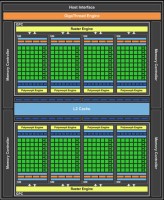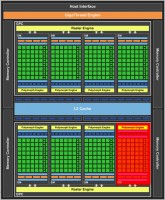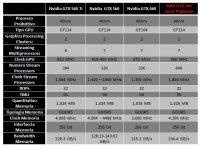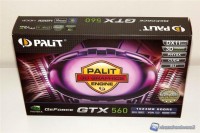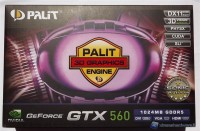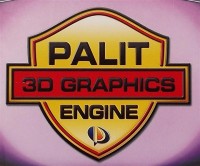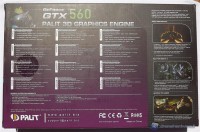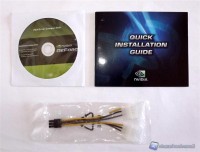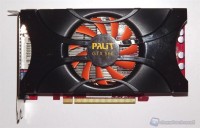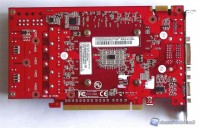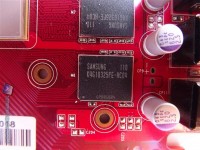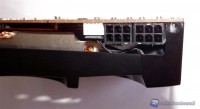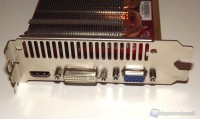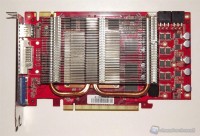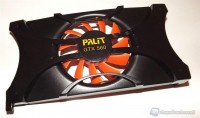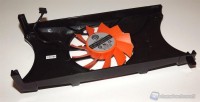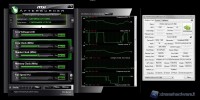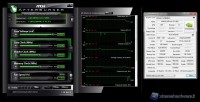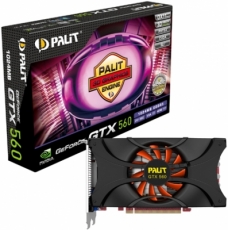
Today we're going to try a new card produced by Palit, it is the GeForce GTX 560 standard version, without the Ti suffix, with the GF114 graphics chip but with 334 Shaders.It's characterized by a highly effective cooling system and very high operating frequencies that make the GeForce GTX 560 Sonic Platinum a video card with very interesting features and especially suited for overclocking.
Palit Microsystems Ltd. is a Chinese company founded in 1988 and headquartered in Hong Kong, specialized in the design, production and distribution of graphics accelerators with the aim of ensuring reliability and innovation in every product. Thanks to its working principles, the company has managed to spread throughout the world by opening offices in Taipei and also in Germany. Through a strong collaborative relationship with customers Palit has managed to be one of the largest manufacturers of video cards, and to maintain the prestige in the world.
The leading company in China, founded in 1992, guarantees the reliability of the components through stringent scrutiny by specialized engineers, to ensure a high quality product, one of the highlights of Palit is also the research, through highly skilled teams, of technical solutions adapted to each market segment.

Over the years the company has expanded greatly also buying the Gainward and Gainward Europe brand regarding the video cards field that, although on the market for more years than Palit, was sold for 1 million dollars. This event led to a significant increase in sales especially in the European market where the Gainward cards were already very popular.
The quality of Palit work is also recognizable by the fact that all company worldwide facilities are ISO 9001 certified and then meet all quality requirements for such certification. All graphics accelerators also have the WHQL (Windows Hardware Quality Labs) certification, granted by Microsoft to all computer products that have passed compatibility testing with Windows operating systems.
You can find more information on the official site: Palit Microsystem LtdFERMI Architecture: Evolution of a species
GF114 is the evolution of GF104 graphics chip, the first version dedicated to the mainstream market of the project based on Fermi architecture from Nvidia. GF104 has represented for this company a great commercial success and with the GeForce GTX 460 has hit the target to offer a card from the large computational capabilities, together with a compact size with very different consumption and heat from the top range.
The launch of the first Fermi version on the consumer market has been entrusted to the GeForce GTX 480 and 470; these two top range proposals have been put in highlight outstanding performance compared to competitors, but at the same time showed the limits of the first realization of project based on GF 100. The well-known problems were represented by consumption and heat during operation quite high. Fermi has emphasized how this architecture would not be adapt to the mainstream. But Nvidia, with the GeForce GTX 460, and a general reengineering of the GF100 graphics chip, was able to offer a card with a new GF104 graphics chip, which virtually eliminates all major defects found in the top range, going to win a slice of consumer market of absolute importance.
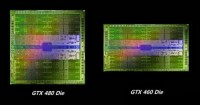
The introduction of the GeForce GTX 560 Ti have marked the evolution of the GF104 graphics chip: the new GF114 GPU allowed to further improve the benefits the old graphics chip already had, proposing a video card designed for medium/high market and that once again proved to be the good enough.
Nvidia takes another step forward bringing yet another video card, that this time bridges the quite high performance gap between the GeForce GTX 550 Ti and GeForce GTX 560 Ti.The GF114 graphics chip, the version with just 336 shaders enabled, has been fitted in the GeForce GTX 560 without the Ti suffix.It can be defined as an evolutionary step of the GF104 GPU, as it has the same specifications except for the operating frequencies. In fact, Nvidia has not proposed its own reference version, but left ample room for AIB partners to present their own video card with very different operating frequencies.
Having had the opportunity to test the 40nm TSMC manufacturing process for the GF114, NVIDIA has decided to use even those GPUs that have shown some problems and were not suitable to be fitted in the GeForce GTX 560 Ti.This was achieved by turning off part of the stream processors so to reuse the discarded chips on the new GTX 560.
FERMI architecture and GF114:
Nvidia has dedicated itself in a very meticulous way to the mainstream video cards market, where consumers usually try to optimally balance the price performance ratio. Just with the GF104 chips Nvidia has achieved this goal. Compared to the GF100, the GF104, and conseguently GF114, graphics chip architecture was redesigned, even if it is also based on the basic common concept of Graphics Processing Clusters (GPC), each consisting of Streaming Multiprocessor (SM).
(GF110 and GF114 chip comparison, versions with all SM enabled)
The Nvidia GF114 chip has a die size of 332 square millimeters, with 1.95 billion transistors and is built using 40nm production technology of Taiwan TSMC foundries. This chip has full support for Microsoft DX11 latest libraries, with 48 CUDA cores, 4 dispatch units and 8 texture units for each SM. Also the GF104 graphics chip has originally 8 SM, but Nvidia opted to enable only 7, in fact, turning one off.This was initially done to maximize yields, to have a greater number of usable chips during the production in the foundries.
In addition, even the not well performing chips, where an SM does not work, were comfortably used by different manufacturers to equip their GeForce GTX460. With the improvement of yields in the 40nm production process it has been possible ensuring increasing number of chips that work with all the 8 SM, so Nvidia, thanks to a new advanced step has been able to churn out chips that have been fully functional equipping the GeForce GTX 560 Ti.
The remainder of the chips defective in the SM were re-used again. The first reason is certainly the reuse of these chips that are not perfect, while the second reason is to cover the hole in the range of performance of the GTX 500 series, where there is an abnormal jump between the GeForce GTX 550 Ti and GTX 560 Ti.
With the introduction of the GeForce GTX 560 without the "Ti" suffix Nvidia is filling exactly this gap.
(The GF114 graphics chip in the final version)
Considering Nvidia GF114 chip in its entirety, in fact it has 2 Graphics Processing Clusters (GPC), each of which has 4 SM for a total of 8 SM. Unlike GF100, where each SM is characterized by 32 Cuda Core, GF104 integrates 48 Cuda Core for each SM, so the GF104 is composed of a maximum of 384 CUDA Core, 64 texture units and 8 PolyMorph engines. But as we said, Nvidia has disabled an SM in one of the two GPC, in this way we have actually 7 working SM and one disabled going to equip the standard version of the GTX 560. So we find 336 CUDA Core, 56 texture units and seven PolyMorph engines.
The PolyMorph Engine unit is responsible for Vertex Fetch, Tessellation, Viewport Transform, Attribute Setup, Stream Output operations and within it there is also the Tessellator unit. In the Fermi architecture the double precision floating point processing power is much higher than the previous architectures and has a value equal to half compared to when code is executed in single precision.
The Nvidia GeForce GF114 chip is currently used in two types of graphics cards that differ in some characteristics. Summarized in the table below the main features of the GF114 chip and of the video card produced by Palit:
Palit GTX 560 Sonic Platinum: overview
As with all GTX 560 video cards also the Palit GTX 560 Platinum Sonic is designed for the latest technologies on the market, the features allow to direct the board in various areas of application.
Microsoft(R) DirectX(R) 11
The video card fully supports the latest Microsoft® graphics library which, thanks to the DirectX® 11 version and to the 5.0 Shader Model, supports the current ultra-performance video graphics, and also GPU acceleration.
With DirectX 11, we can use Tessellation technology to have a more richly detailed graphics quality, this technology uses, in fact, a "tessellator" which, according to the distance between an object and the camera, divides more the polygons that make up the object, thus an object at close distance will be much more complex than when seen from afar. This does not only enhance the graphics apperance of a video game, but also makes sure that the GPU resources are better managed thus ensuring less performance waste when an object is located away from the camera.
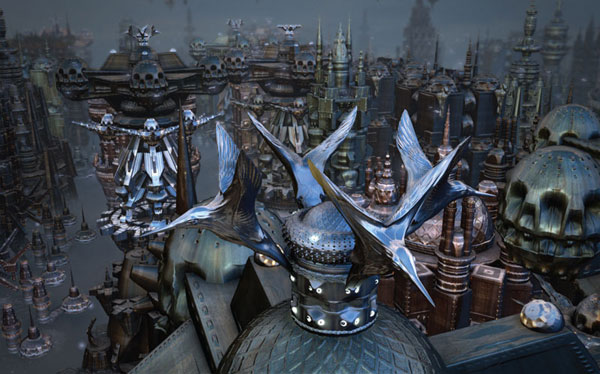
With the advent of DirectX 11 the support for multi-core CPU has been improved in order to have superior performance in both gaming sessions and in those of video or 3D objects rendering.


Through Direct2D technology, DirectX11 libraries also offer improved performance when using web browsing software like Internet Explorer 9 and Mozilla Firefox 4.0.
NVIDIA(R) PhysX(R)
With NVIDIA (R) PhysX (R) you can reach an element of realism never seen before in games.Using the NVIDIA (R) GeForce (R) on your PC, you can enjoy a dynamic experience with PhysX (R) effects like flaming explosions, reactive debris, water, and realistic characters with lifelike appearance.
Originally, this technology was used only by dedicated video cards that has been produced by the Ageia acquired by Nvidia in February 2008, and integrated into its GPUs starting from the GeForce 8 series.Through the implementation of the APEX library, PhysX technology has reached very high levels of realism, the first title to take advantage of the APEX library Mafia 2 was produced in August 2010. APEX libraries including the following features: APEX Destruction, APEX Clothing, APEX Vegetation and APEX Turbulence.
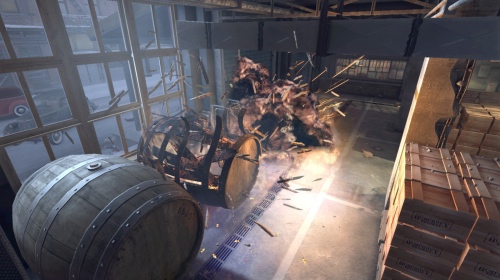
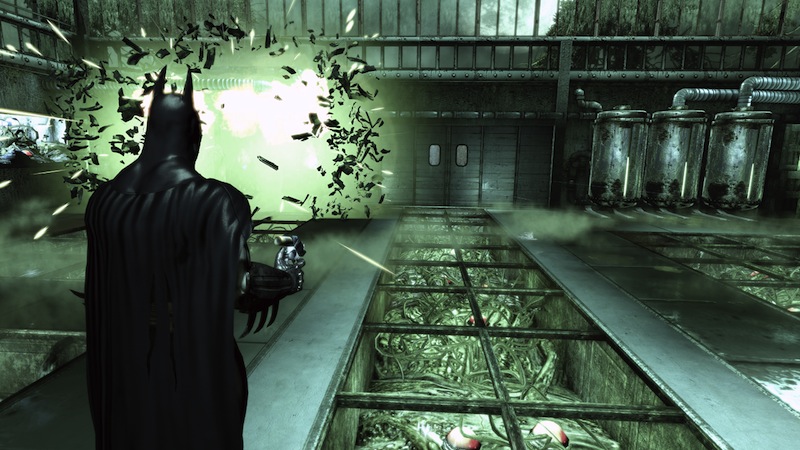
NVIDIA(R) SLI(R)
The Scalable Link Interface (SLI) was developed by Nvidia to be able to connect two or more video cards to produce a single output video signal. This technology was used for the first time in 1998 in the Voodoo 2 video cards but was not very successful due to poor performance gains. After the acquisition of 3DFX by Nvidia the technology has been reintroduced in 2004 with the same purpose but with much better performance.
In the latest generation of video cards you can select two different criteria for distributing the workload between the video cards operating in parallel:
Alternate Frame Rendering (AFR): it renders in sequential mode so that a video card renders odd frames while the other even frames.
Split Frame Rendering (SFR): the rendering is split between the boards in variable percentage.

NVIDIA(R) 3D Vision(TM)
By combining a last generation Nvidia graphics card with a NVIDIA(R) 3D Vision(TM) kit, it is possible to enjoy a much more rich 3D experience on your PC or on your workstation. This technology uses a 120Hz monitor and a pair of active eyeglasses that block the lens alternatively, such that the images intended for the left and right eyewere drawn on alternate frames.Thus each eye perceives a signal equivalent to the 60Hz frequency of the current monitors.
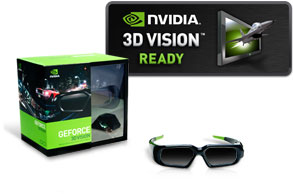
NVIDIA(R) 3D Vision(TM) Surround
3D Vision technology from Nvidia can in turn be applied to three monitors simultaneously using two Nvidia GF110, both cards will work in AFR mode (Alternate Frame Rendering) dividing the frames, and then the work.
Obviously, the GTX590 are able to manage this technology through the use of a single card as they are multi-GPU video cards.

NVIDIA(R) CUDA
Compute Unified Device Architecture (CUDA) is a hardware architecture for the development of performant calculations produced by Nvidia. This technology allows to increase the calculation performance in demanding applications, especially in the software used by programmers and developers.
The CUDA programming languages available are extensions of the most popular programming languages, the most common is C-CUDA (C with Nvidia extensions).
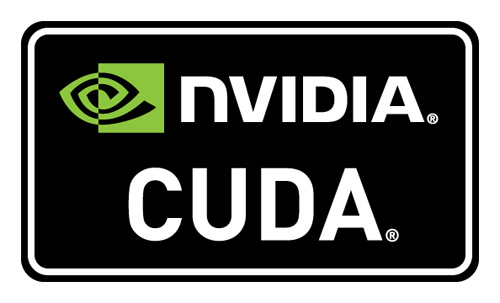
NVIDIA PureVideo(R) HD
NVIDIA (R) PureVideo (R) carries the film in everyday life. PureVideo uses advanced techniques that are usually found on high end systems in the consumer market players. TV suitable for the Blu-ray, HD DVD and regular DVDs, PCs and mobile content offering crisp, clear and defined images.Whether you're watching on an LCD or a plasma TV, with PureVideo image will always be accurate and realistic. Some formats supported are H.264, WMV and MPEG-2 HD and SD.
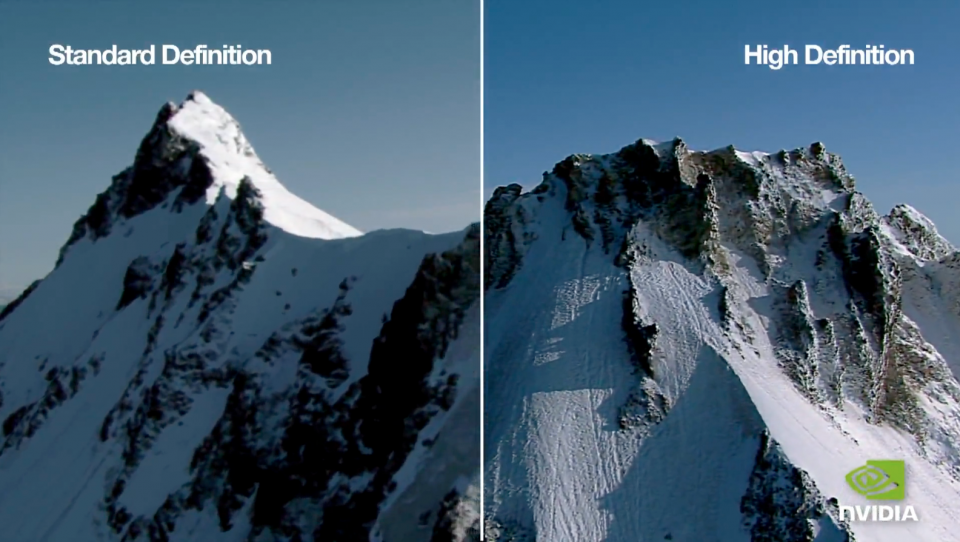
Blu-Ray 3D Support
It's possible to display an high quality 3D at home with support for 1080p Blu-ray 3D, through this type of discs you can view 3D compatible content through the HDMI 1.4a port, using active-shutter glasses, or polarized passive type on suitable screens.
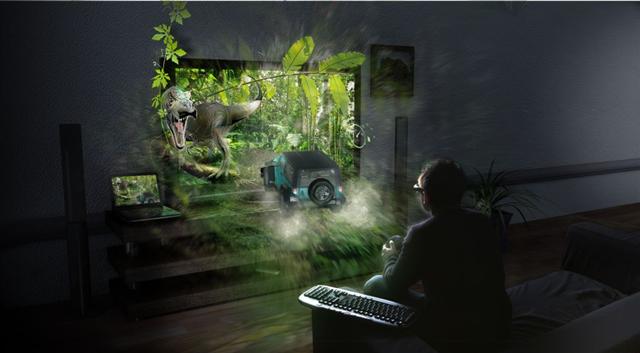
Hardware Video Decode Acceleration
The combination of video acceleration and high definition decoding and post-processing provides an unprecedented picture clarity, smooth video, accurate color, and precise image scaling for movies and video.
Other features include:
- PCI Express 2.0
- Dual Link DVI
- TrueHD and DTS-HD Audio Bitstreaming Support
- HDMI Output
Palit GTX 560 Sonic Platinum: package and bundle
The video card proposed by Palit is equipped with GF114, is sold in a carton aesthetically very wel made, very compact and solid in order to prevent damage from shock during transport. The graphics used are very similar to those seen in the other version of Sonic Platinum cards.
The front of the box is characterized ,in the central part, with the Palit 3D Graphics Engine logo, while in the top left corner there is the name of the manufacturer, Palit, while in the right side, always at the top, are the main features like DX11, 3D Vision, PhysX, Cuda and SLI.
In the lower right corner a stamp printed on the packaging states that the card contained belongs to the Platinum Sonic family, while at the bottom of the box we have the NVIDIA logo, followed by the words GeForce GTX 560, and the amount of on board memory that our case is 1024MB of GGDDR5 type. It is given emphasis on the DVI, VGA and HDMI outputs.
On the back of the box are listed all the main features about the video card in several languages including Italian.Once you open the package there is another box where the card and the bundle included are inserted. The video card is wrapped in an antistatic bag, protected by bubble wrap that envelops it very accurately.
In other areas located on the edge of the box are 2x6pin to 8pin cable and VGA to DVI adapters. Removing the card, instead, we find the installation manual and driver CD. The bundle contains the minimum necessary for proper operation. Here then listed the bundle:
- Drivers CD containing the card drivers
- Manual
- DVI to VGA Adapter
- 2x6pin to 8pin adapter
Palit GTX 560 Sonic Platinum: the card
The card shows a very clean and compact design. The red PCB has a length of only 18.8 cm: this ensures that the card has a very small overall size and can be easily mounted in rather compact cabinet.
The Palit GTX 560 Sonic Platinum shows a cooling system with central fan; as we can see from the next pictures the heat sink is covered by a black plastic protection that has aesthetic features but also conveying air. The rear of the PCB does not show if not for the special component arrangement which is very simple and orderly. By removing the plastic housing to which the fan is anchored in, we note that the cooling system is composed of thick plates of aluminum crossed by two pure 0.8mm copper heat pipes that transmit heat from the GF114 chip to the cooling system.
Removing the heatsink we see at the center the graphics chip, protected by an IHS, as Nvidia as has accustomed us, which is labeled GF114-325-A1. The term A1 indicates that the chip belongs to the first (and so far only) version produced.
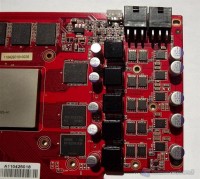
Just to the right of the power circuitry there is a connector for the PWM fan and two 6pin + 6pin power connectors positioned laterally. Close proximity to the GPU is the connector for the SLI, so we can use up to two video cards in parallel in 2-way SLI mode.
The Sonic Palit GTX 560 Platinum has very high operating frequencies, compared to other competitors.The frequency of the graphics core has been increased to 900MHz and the shaders have been set at 1800 MHz, GDDR5 memory type are set to a factory operating frequency of well 4000 MHz. We can clearly infer these features from the screen performed using the GPU-Z software.
Palit GTX 560 Sonic Platinum: the cooling system
The cooler is rather simple: the main body, as already mentioned, consists of a radiator composed of 40 aluminum fins, the size of about 7 x 12.5cm. In this lamellar system come from the pure copper base two large 0.8mm heat pipe to transmit heat from the graphics chip and transfer it to sink. The radiator is fixed to the board by screws.
To cool the lamellar body a thermo-controlled PWM fan was installed, orange in color, produced by Power Logic; on the back it shows the PLA08015S12HH label. This fan is of Sleeve Bearing type with a diameter of 80mm and a height of 15mm. The 11 blades that make it up have a very particular shape as to ensure a good flow of air, limiting turbulences, so the card is very quiet.
The black PVC protective cover, in addition to the pure aesthetic function, directs the cold air in a tangential relation to the fan, so the hot air stream generated by contact with the fins pack is leaked both from the rear exit slots exiting by the fissures above the video outputs both on the front of the card, going in part within the cabinet.
The test system and testing methodology:
We tested the video card produced by Palit on the following test system:

These are the included applications, divided into two different types:
Synthetic Benchmark:
- 3D Mark Vantage - DX10
- 3D Mark 2011 - DX11
- Unigine Heaven Benchmark V 2.1 - DX11
- Stone Giant Benchmark - Dx11
- ComputeMark - DX11.
Games:
- Crysis Warhead - DX10
- FarCry2 - DX10
- Mafia 2 - DX10
- Resident Evil 5 - DX10
- Final Fantasy XIV - DX10
- Colin McRae DiRT 2 - DX11
- Aliens vs Predator - DX11
- Metro 2033 - DX11
- Stalker Call of Pripyat - DX11
- Lost Planet 2 - DX11
- Tom Clancy's H.A.W.X. 2 - DX11
- Formula 1 2010 - DX11
The tests were performed using the system described in the diagram above, using Microsoft Windows 7 Ultimate x64 operating system updated to Microsoft's official SP1.
The drivers used for this test are as follows:
- Catalyst amd_catalyst_11.5a_hotfix_8.85.6rc1_win7_may5 for the Radeon HD 6990 4GB
- Catalyst 11.5 WQHL for 1GB Radeon HD 6790
- 11.3 WHQL Catalyst for Radeon HD 6800 series, Radeon HD 6970, Radeon HD 6950, Radeon HD 5700 series
- Catalyst 8.84.2 RC2 Win7 March 23 for AMD Radeon HD 6450, HD 6570 and HD 6670
- Forceware 260.99 WHQL for GeForce GTX 400 series
- Forceware 266.58 for GeForce GTX 500 series
- Forceware 270.xx for the GeForce GTX 550 Ti
- Forceware 275.33 for the Sonic Palit GeForce GTX 560 Platinum.
3D Mark Vantage
Synthetic benchmark developed by Futuremark, necessarily requires the presence in the system of a video card with support for DirectX 10 API and a Windows Vista or 7 operating system. The benchmark consists of 6 separate tests: 4 focused on the GPU and 2 on the CPU. The tests are performed in up to 4 presets configured by Futuremark, characterized by a different level of workload in order to better reproduce the typical scenario of use of your system depending on the hardware configuration in use. The software allows you to set the Entry, Performance, High and Extreme configuration. The tests were done only in Entry, Performance and High mode.

The Platinum Sonic 560 goes above the reference version of the AMD Radeon HD 6870 and immediately below Nvidia's GTX 560 Ti. The differences also with the GeForce GTX 460 is very marked, by virtue of the very high operating frequencies.
3D Mark 2011
Last Futuremark benchmark product, which requires the presence of a video card with support for DirectX 11 API. The developer software house says that testing on the tessellation, volumetric lighting and other effects used in modern games make the benchmark modern and indicative of the actual performance of video cards.3DMark 11 Advanced Edition allows you to set the benchmark in three modes for DX11, Performance, High and Extreme. The first test scenario based on the Deep Sea, does not apply the tessellation but it uses a marked system of lighting and shadows. The second test, again based on Deep Sea, apply a medium level of tessellation and reduces, even in this case at the intermediate level, lighting. The third graphic test, based on the scenario High Temple, has a level of tessellation medium and low light. The benchmark does not take advantage of NVIDIA PhysX technology.
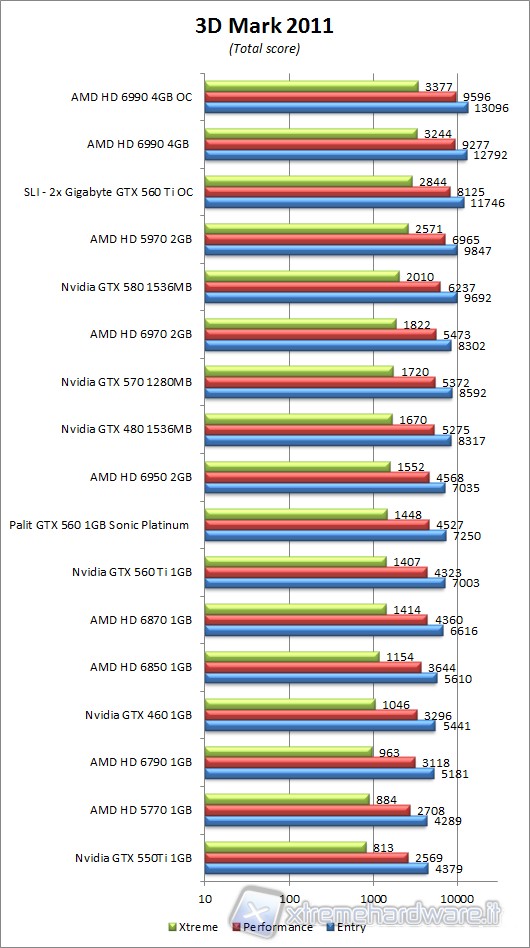
In this case, the Palit proposal, is positioned above the GeForce GTX 560 Ti albeit very marginally.
Stonegiant
Benchmark compatible with DirectX 11 API, the Swedish developer of BitSquid graphics engines and of Fatshark games, which puts particular stress to the video card with tessellation techniques. It's a tech demo with DirectX 11 integrated benchmark, created to reveal the BitSquid tools and technology. Users who have a DX10 GPU can run tech demo with tessellation disabled. These are the notes supplied with the product by the developer:
- Highly parallel, data oriented design
- Support for all new DX11 GPUs, including the NVIDIA GeForce GTX 400 Series and AMD Radeon 5000 series
- Compute Shader 5 based depth of field effects
- Dynamic level of detail through displacement map tessellation
- Stereoscopic 3D support for NVIDIA 3dVision
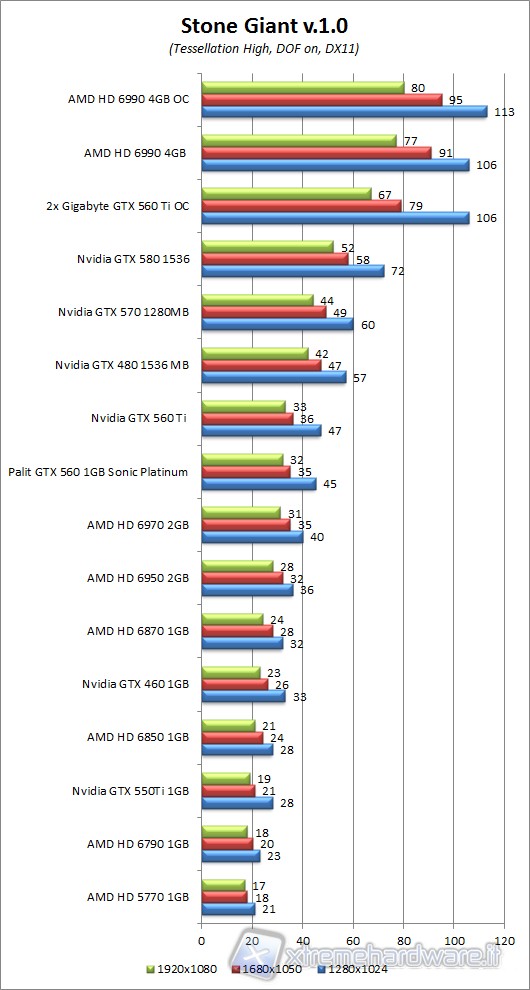
The GTX 560 Sonic Platinum is positioned above the AMD Radeon HD 6970 and the GeForce GTX 560 Ti reference.
Unigine Heaven 2.1
Unigine has unveiled the latest version of its DirectX 11 benchmark, which allows users to test his video card with the new graphics library. Based on Unigine engine, the benchmark Heaven supports DirectX 11, DX 10, 9, OpenGL video cards and Nvidia 3D Vision Surround. The benchmark has been tested in DX11 and with tessellation on the Extreme setting.
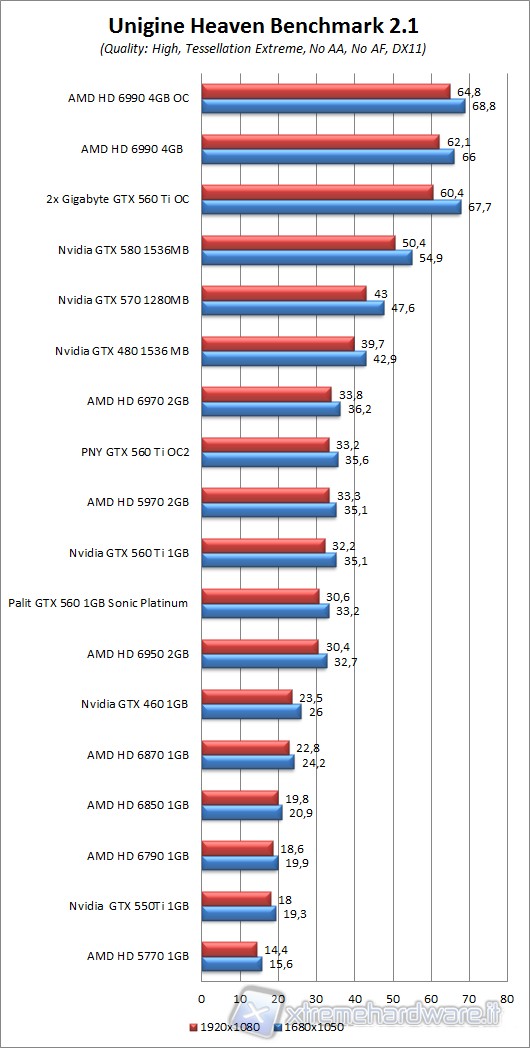

As for Stone Giant, even for Unigine Heaven Platinum Sonic is positioned just below the Nvidia GeForce GTX 560 Ti as seen in other benchmarks.
ComputerMark
It's the first benchmark that measures the shader computing ability, in DX 11 windows environment, of new VGA. It's the first DX11 only benchmarks.
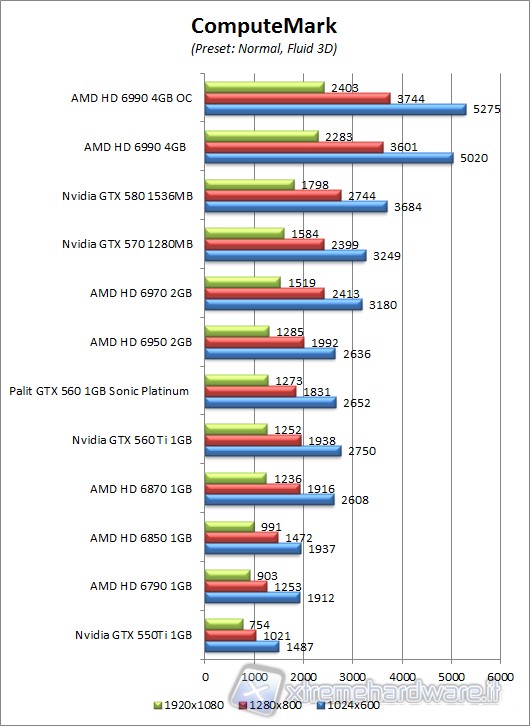
In this case the Palit proposal is positioned slightly above the Nvidia GTX 560 Ti, although we can say that the two proposals are about the same. The Palit, having a lower number of stream processors compared to the Ti version, is able to recover due to higher frequencies.
Crysis Warhead
Crysis Warhead is a sci-fi video game first-person shooter, released in autumn 2008 in Italy.It is a stand-alone expansion to Crysis, developed by Crytek Budapest and published by Electronic Arts. The game is set in a parallel story of the first episode, and the player will assume the role of Sergeant Michael 'Psycho' Sykes, a former member of the British SAS, although the plot is almost completely different, since in the first episode the Nomad meets him rarely. As the names imply, Psycho is a type completely different from the Nomad, while the latter is in fact, dedicated to the subterfuge, Psycho is a type of action, and will therefore have a greater arsenal, as well as customized vehicles. It should also be said that Crysis Warhead is not part of the trilogy in the series, since the second episode will be developed later.
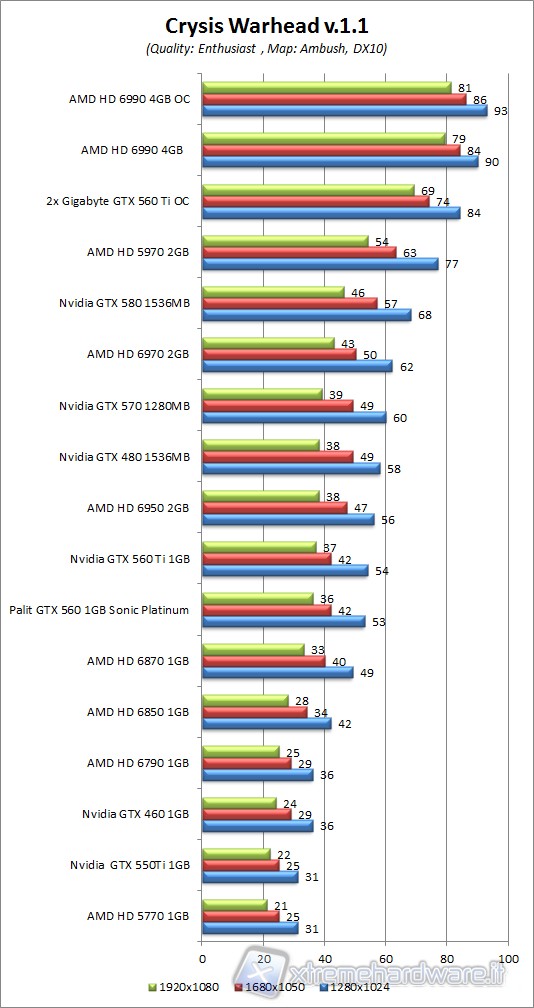
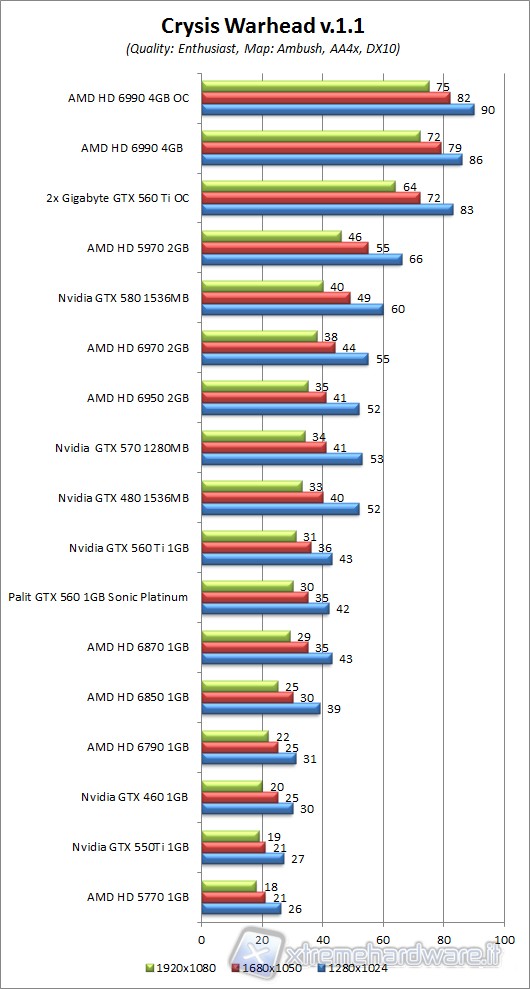
The same situation is repeated, ie comparable performance between the proposed Palit and GTX 560 Ti.The difference amounted to as much as one frame per second between the various settings.
FarCry2
Far Cry 2 is the second episode of the first person shooter video game Far Cry. The game was developed by Ubisoft, which announced in March 30, 2006 that it has acquired all intellectual property rights for the brand from the creators of Far Cry , Crytek.Ubisoft, according to an official statement, will continue to develop new video games in the series thanks to the permanent license to use the game engine, Crytek CryEngine . The player will play former U.S. Army Special Forces member Jack Carver. Far Cry is gone down in history mainly due to its graphic engine, developed by Crytek CryENGINE . At the time of its release, in fact, the graphics of Far Cry was the best had ever seen, capable of reproducing the vegetation and, especially, the water, with the limit of photorealistic quality. The islands on which each level was set was huge, and the player enjoyed almost complete freedom, as he preferred to explore . Even the enemies were, at that time, the most intelligent ever seen in a shooter: for the first time the computer opponents were not leaving the position like crazy suicide, and for the first time we saw enemies who tried to bypass the player and take it from behind, and often they could.
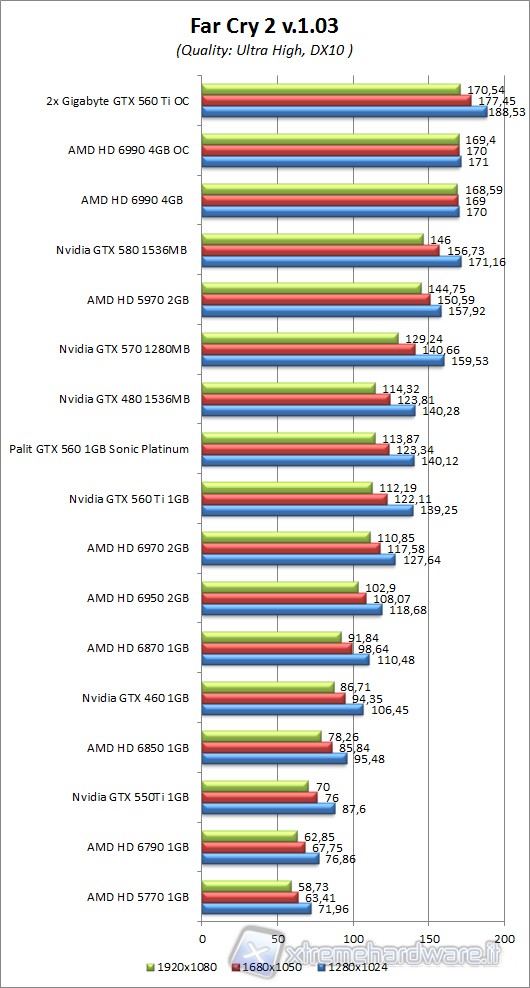
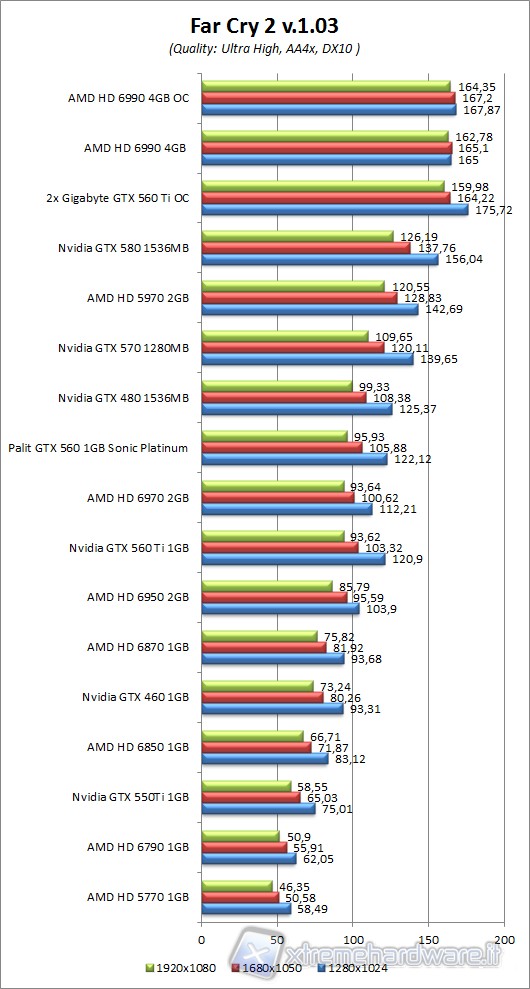
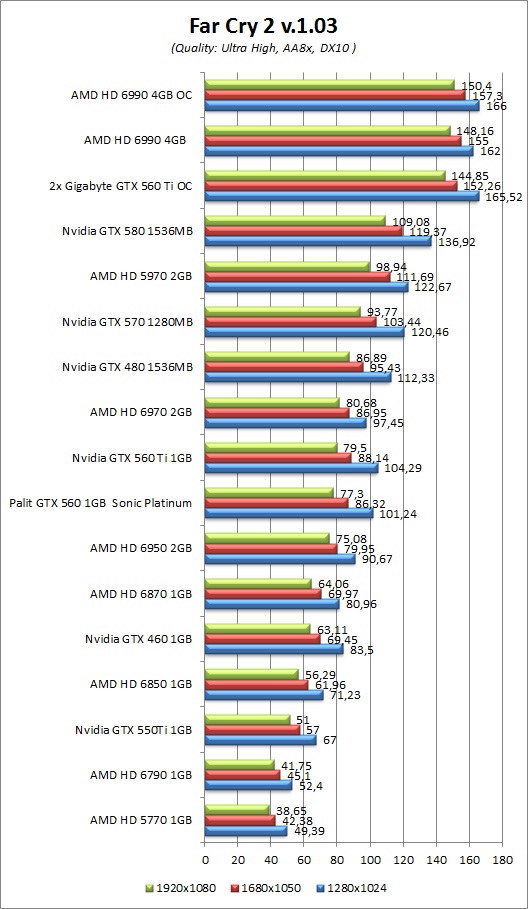
In Far Cry 2 the Sonic Platinum manages to overcome in all situations the GeForce GTX 560 Ti, even if the margin is not high.
Mafia 2
Mafia II is a sci-fi video game, following Mafia developed by 2K Czech and published by 2K Games for PlayStation 3, Xbox 360 and Microsoft Windows.The game takes place from 1943 to 1951 in the town of Empire Bay (the name refers to the nickname of New York "The Empire State"), a fictional city inspired by circles in Los Angeles and New York City, with influences of Chicago and Detroit. The game is characterized by a fully explorable map of 26 square kilometers, there are no limitations from the beginning of the game. There will also be about 50 vehicles and original music of the period. Many firearms be repeated from the first game and will make their debut, however, weapons of World War II.

Same situation already seen in the benchmarks, the Palit GTX 560 Sonic Platinum has very similar performance to the GeForce GTX 560 Ti.
Resident Evil 5
Resident Evil 5, known in Japan as Biohazard 5, is a game of survival horror genre, and is the eighth installment of the main Resident Evil games, is released for the PlayStation 3 and Xbox 360. The game, developed and published by Capcom is set eleven years after the Raccoon City disaster, which occurred in 1998, and five after the adventure of Leon S. Kennedy in Spain, which took place in 2004. In 2009, Chris Redfield, former STARS member of special team, he joined a company that fights against bioterrorism, called BSAA Is sent into the heart of Africa, specifically in the region of Kijuju, to investigate a mysterious threat of bioterrorism. Li made the acquaintance of a girl, Sheva Alomar, member of the African branch of the BSAA The two soon discover the horrors of the place: the natives of Kijuju have been infected by a mysterious parasite, which sentenced them to remain in a permanent state of murderous rage. The two agents B.S.A.A. then deal with the hordes of enemies, called Majini, looking at the same time to prevent the spread of the parasite. At the same time Albert Wesker, a former captain of STARS and nemesis of Chris, he went to Africa to work with Excella Gionne, the owner of the pharmaceutical company Tricell. Wesker, helped by a mysterious hooded woman who does the dirty work for him, trying to counter the plans of the BSAA, intent on world domination.
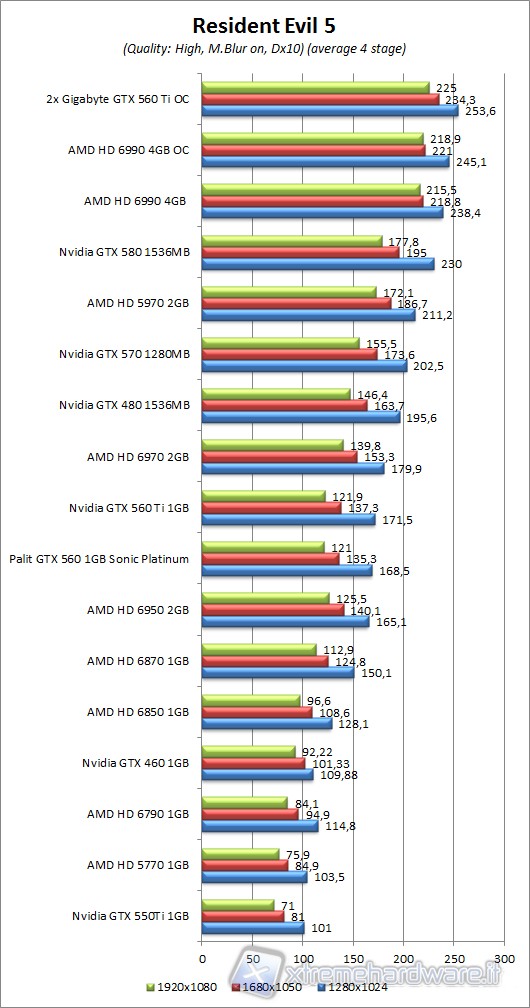

In this case we have results in mid-way between the AMD Radeon HD 6950 and HD 6870.
Final Fantasy XIV
Final Fantasy XIV is the second of the MMORPG Final Fantasy series, published by Square Enix and released September 30, 2010 for Microsoft Windows, while the PlayStation 3 version was released in 2011.The universe of Final Fantasy XIV is represented by the characteristic elements of the fantasy genre and the typical elements of the Final Fantasy series.The world on which is set the game is called Hydaelyn, while all our adventures take place mainly in the region of Eorzea, which includes the contintent of Aldenard and all the surrounding islands. Throughout the kingdom can be found from the harshest climates and inhospitable to the more gentle and temperate, as varied and vast as its landscapes. Large forests and desert plains stretching to the horizon hiding inside as varied as ferocious creatures. Various city-states are contending and splitting the territory. At the beginning of the game the player can create a character from one of the 5 playable races. Each race also is in turn organized into 2 clans.
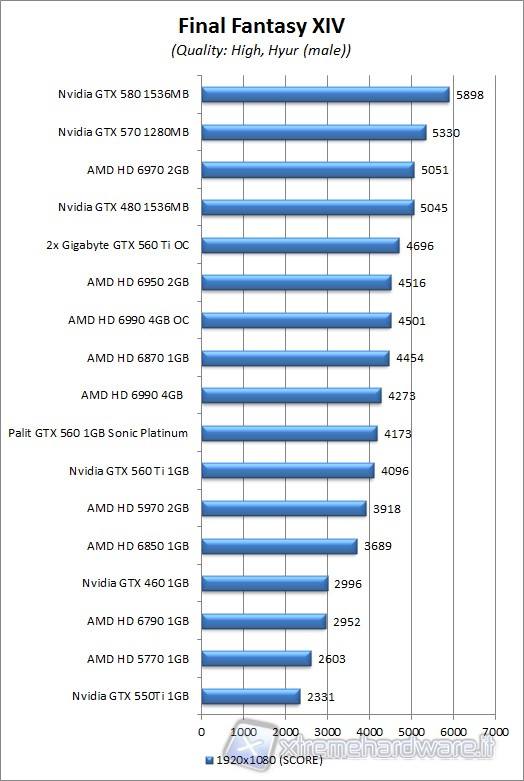
The Final Fantasy XIV Benchmark evaluates the performance of our video card based on the frames per second resulting in a final score that goes, in this case, a little under the AMD Radeon HD 6870.
Dirt2
The game is based on Ego technology, which we also see in the next chapter of Operation Flashpoint.Dirt 2 has a World Tour mode that allows you to compete in various locations around the world : Utah, Japan, Malaysia, China, Croatia, Baja California, Morocco and London. Race modes are very different, like Rally, Race Time, Destroy the Gates, Raid, and Elimination, Domination, beyond the simple "classical race" The rally becomes an even more extreme and adrenaline sports with Colin McRae DiRT 2: exciting new racing head to head, drawn by the impressive realism and special events in stadiums and spectacular circuits. From London to Malaysia, Morocco in Los Angeles, conquers the world of off-road racing!... ..The game supports DirectX11.

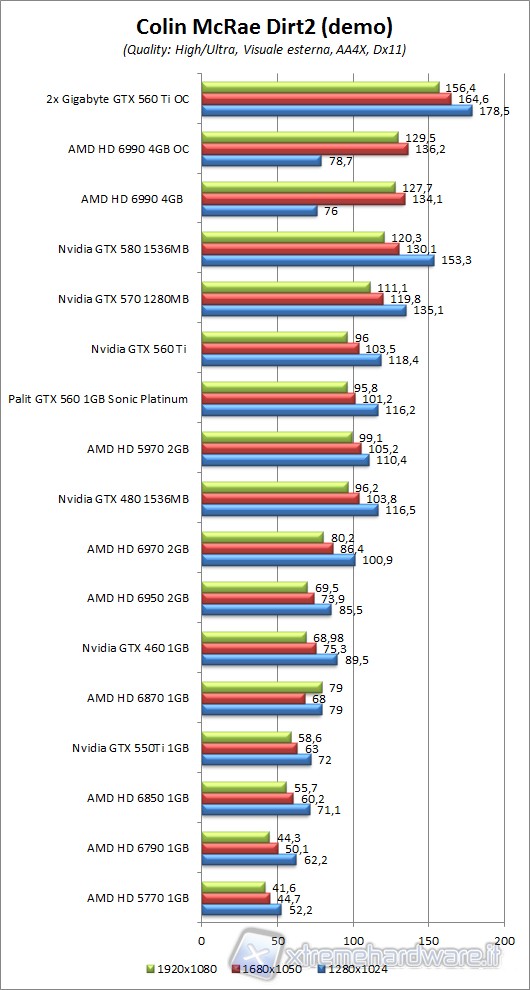

The Palit GTX 560 Sonic Platinum is positioned even above the GTX 480 when using a 4x Anti Aliasing filter.
Aliens vs predator
Alien vs. Predator (AVP) is a first-person shooter video game developed by Rebellion Developments, creators of the other two titles dedicated to the franchise. The game was published by SEGA. The game offers the player to interpret one of three different breeds, each with its own characteristics: Marine, Predator and Alien. Alien has the wide-angle view and can fall from heights unimaginable without the slightest damage, but, above all, can walk (and run) on the walls, and this significantly changes the way they deal with the paintings. At first it is easy to move with ease and speed through a vertical wall to a ceiling as if nothing had happened, after few minutes start "to like it" ...Here are a Marine, a shot of claws in the race and the sea is dead. Easy. Here's another marine, is can see, we run the meeting, has the flamethrower. Let's burn together. And now the Predator.
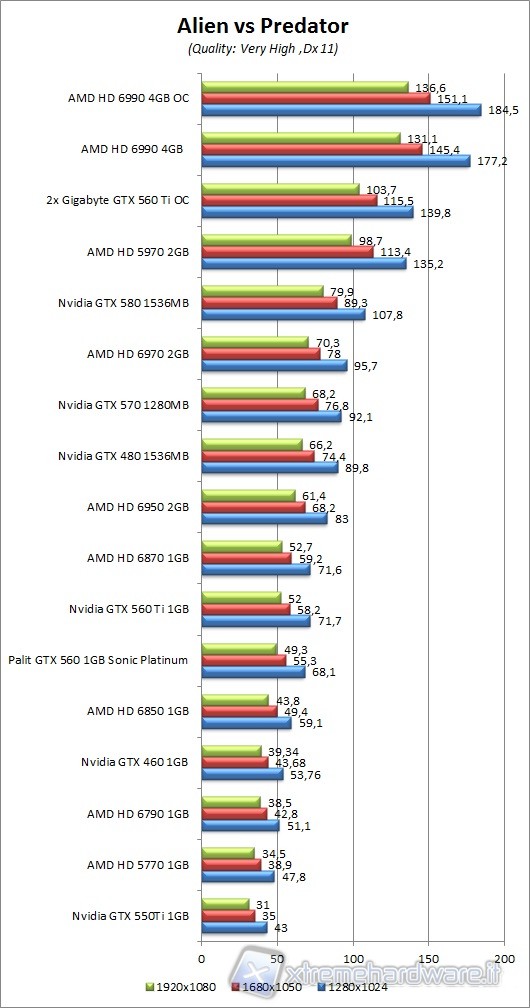
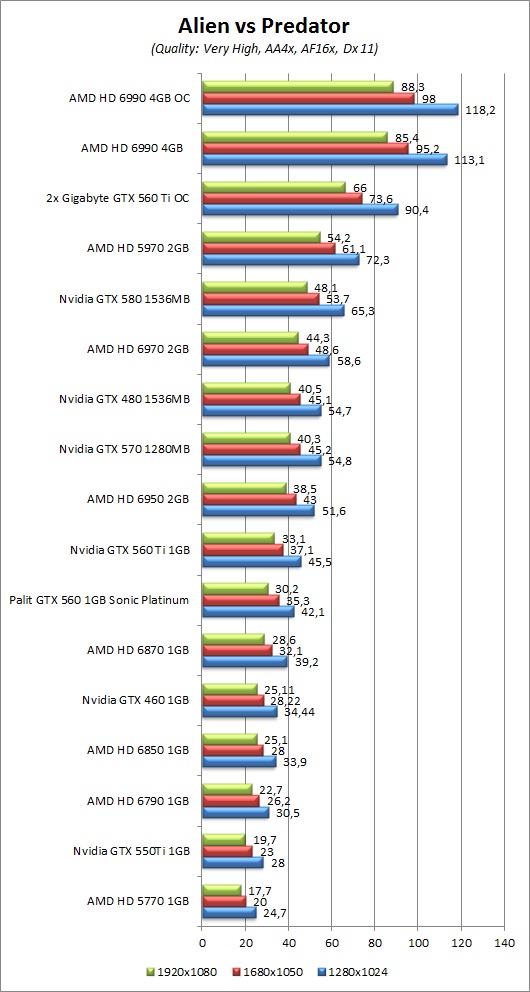
The Palit board is faced with the AMD HD 6870 where it manages to have better overall performance, especially pushing the image processing filters at their maximum.
Metro 2033
Metro 2033 is a video action game that combines elements of survival horror and first person shooters. game is based on the novel of Russian writer Dmitry Metro 2033 Glukhovsky. It was developed from 4A Games and published in Ukraine in March 2010 for the Xbox 360 and Microsoft Windows. It is in the city of Moscow in the year 2033.Following a nuclear disaster, the survivors are forced to live underground in the Russian capital, organized in stations similar to city-states.In the latter an atmosphere oppressive and distressing. The darkness hides many pitfalls, including the frequent opportunities to run into monstrous creatures that populate the station. The main threat is represented by Tetri, defined as new homines, "won the battle for survival", and destined to inherit the Earth.
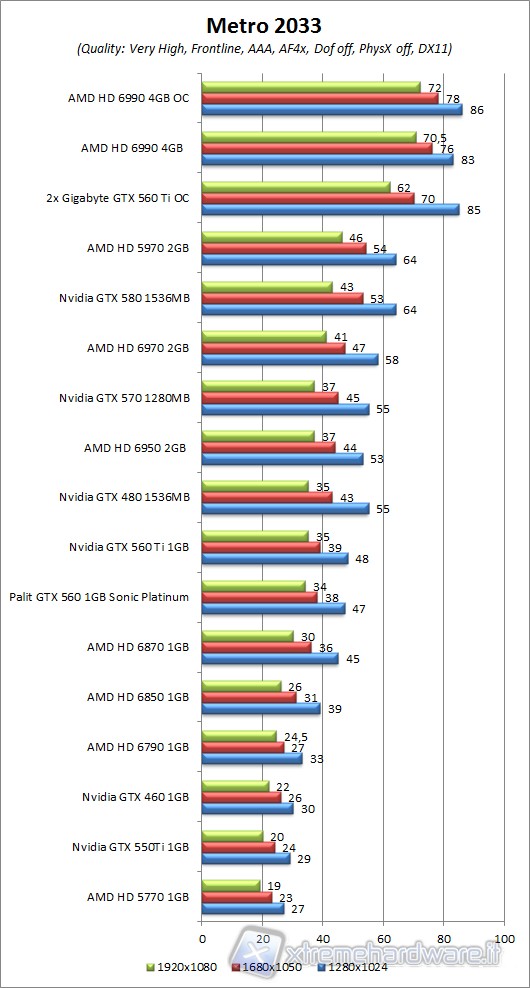
The performance seen in this case are halfway between the HD 6950 and HD 6870 AMD's reference.
S.T.A.L.K.E.R.: Call of Pripyat
STALKER: Call of Pripyat is a first-person shooter of post-apocalyptic science fiction genre, developed by GSC Game World and published October 2, 2009 (February 5, 2010 in Europe).It is the third installment of the series and is placed chronologically after the events of STALKER: Shadow of Chernobyl, the founder of the saga. STALKER: Clear Sky, the second chapter, is the prequel. Like the previous ones, STALKER: Call of Pripyat was developed with the proprietary engine X-Ray. A group of Stalkers reached for the first time the central core of the entire Zone, the Chernobyl Nuclear Power Station.The already harsh situation in the area is complicated and there is a real risk of a catastrophe. A great power is abnormally changing areas, there are still areas to be considered safe, but for most the whole area is now full of strange anomalies. Many of the Stalkers and the other inhabitants of the area have died as a result of these changes, while new areas appear anywhere in the territory. The area is now very unstable, what to do to stop the anomalies? The game supports DirectX 10.1.

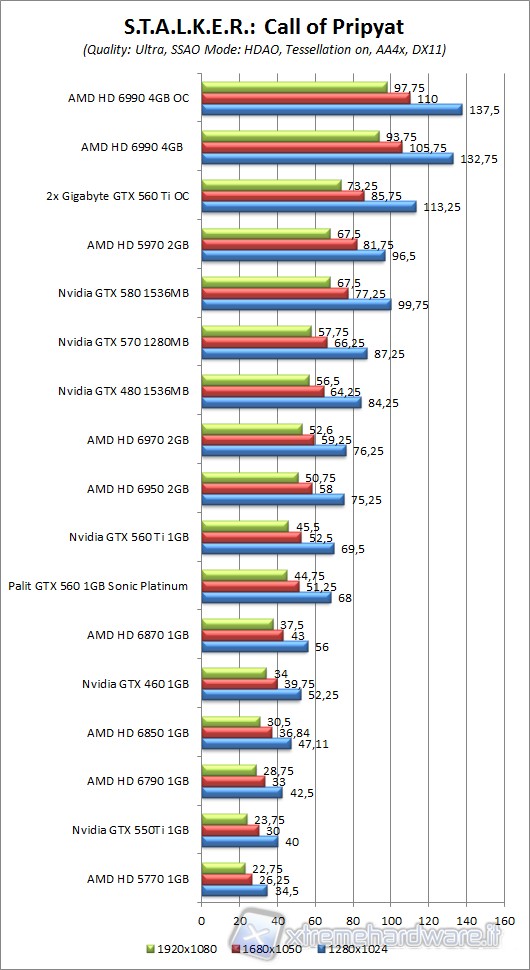
Lost Planet 2
Lost Planet 2 is a game produced and developed by Capcom and released from Halifax for PS3, Xbox 360 and PC. It was initially to be released in early 2010, but Capcom has put off the end of 2010. The game is set 10 years after the adventure of Wayne Holden on Lost Planet, and things have changed: Thanks to the efforts of Wayne and his friends, EDN III, the planet where the game is played, began a slow terraforming process, which has caused a drastic climate change. In fact, if in Lost Planet 1, the planet was only arctic, there are now desert areas, areas with dense tropical jungles, areas with warmer climates, etc.. But this has not brought peace, indeed, now that the world is more populated by humans, they are again divided into bands and real snow pirate clans involved a constant and perpetual civil war for control of the planet and the EN-T, the liquid substance used by humans as fuel for their technology, both from the Akrid, the indigenous creatures of EDN III, which are a perennial problem for humans as they are very aggressive and difficult to kill.
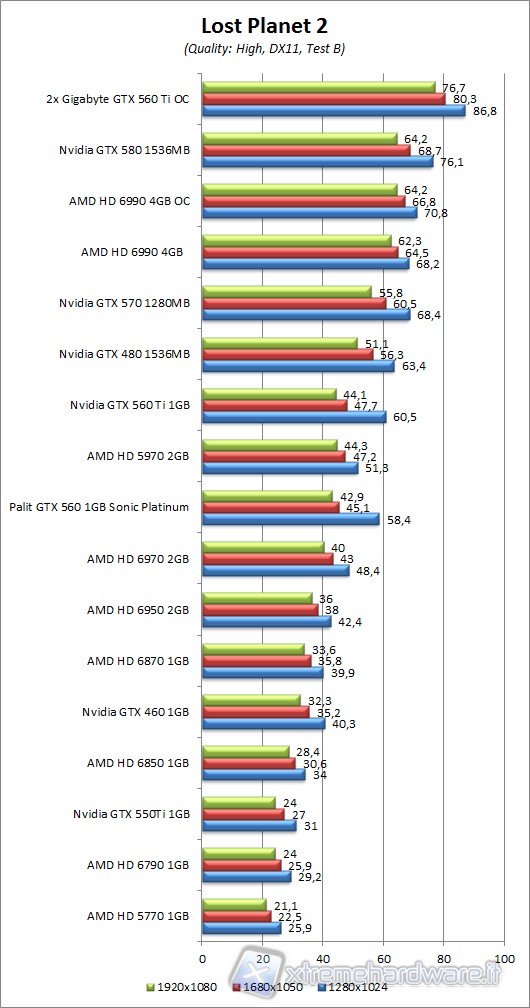
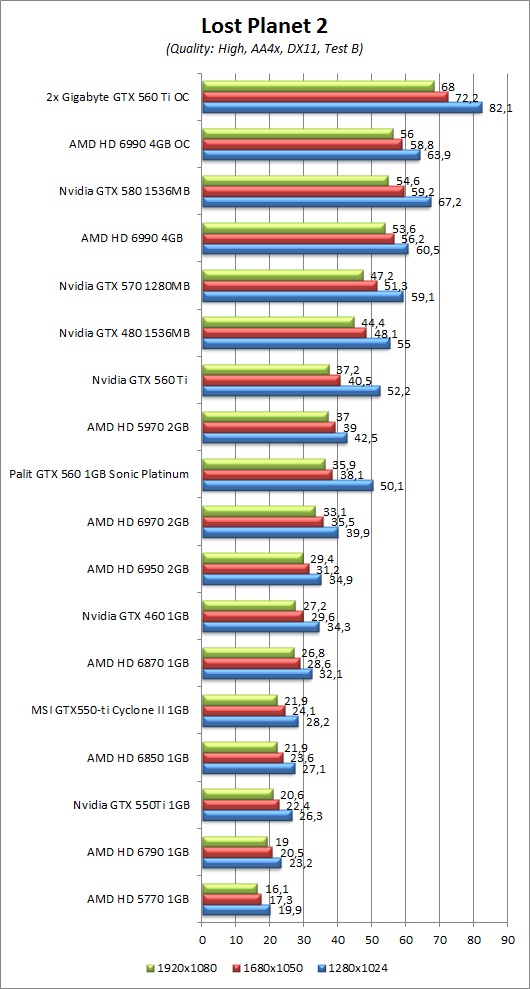
The GTX 560 Sonic Platinum manages to overcome even the AMD Radeon HD 6970, which in this case does not prefer too much this benchmark.
HAWX 2
Tom Clancy's H.A.W.X. 2 ("High Altitude Warfare Experimental") is the second version of flight simulator developed by Ubisoft Romania available for PC, Xbox 360, PlayStation 3 and Nintendo Wii. During the action, the pilot has available several new features over the previous version: night vision to conduct attacks in stealth mode, anti-radar pod that distracts an opponent and prevent him from attacking, the ERS (Enhanced Reality System), which traces a route through virtual dangerous traits in a safer manner. It can also make new flight procedures such as takeoffs and landings from marine platforms and aircraft carriers, air refueling, using bombs and missiles and precision guided. Several missions also provide support to allied units, land, sea and sky. The game has different views: in the first and third person view cabin (with realistic instrumentation), battle-mode plane (third-person view on the battlefield). The pilot data are maintained during all phases of the game, statistics, performance, and can present experience, as well as upgrades and aircraft unlocked (PEC rewards - Persistent Elite Creation). The satellite information, aerial and geospatial data in the game are provided by GeoEye.
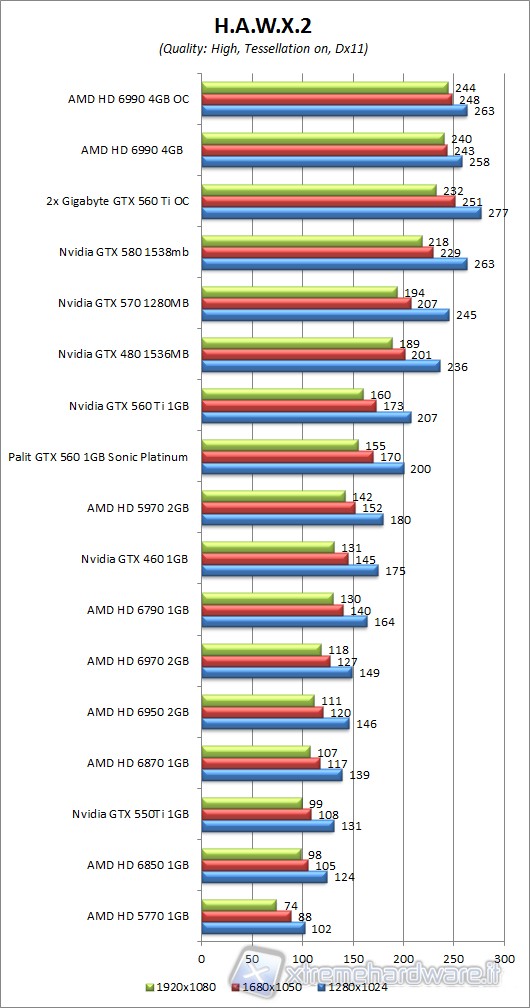
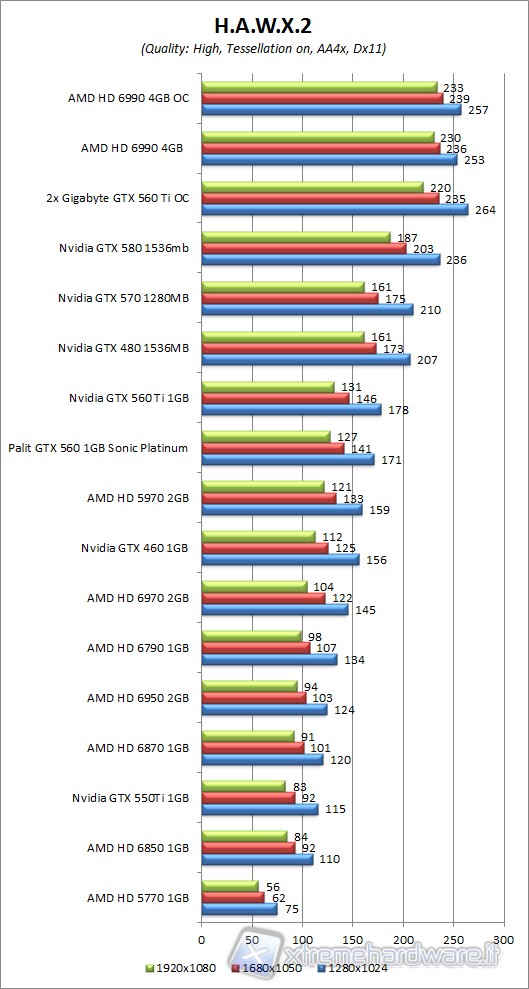
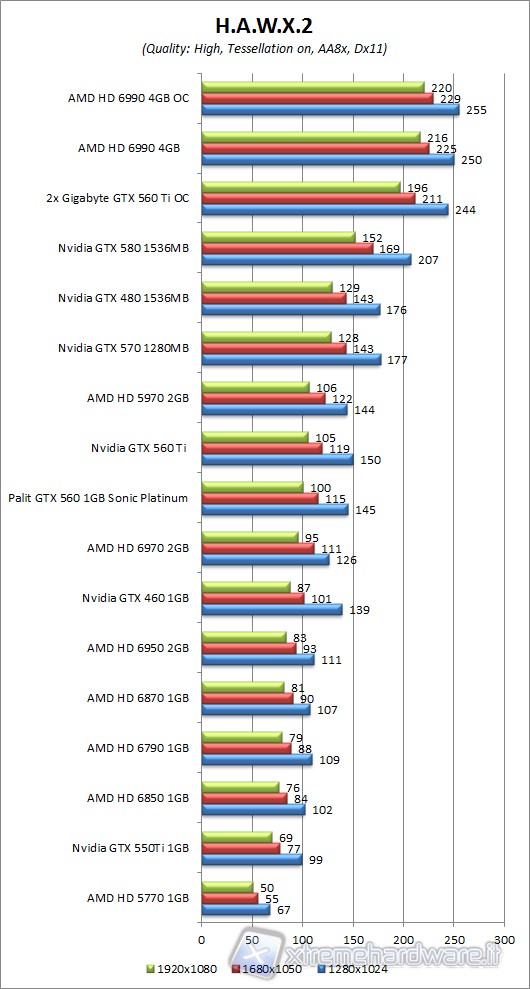
The performance of Sonic Platinum are, in this case, slightly lower than the GeForce GTX 560 Ti, but in any case the frames are generated very fast.
F1 2010
F1 2010 (or even Formula 1 2010) is a driving video game produced by Codemasters, based on Formula 1 2010 World Championship. It has revamped graphics, with the introduction of spectacular helicopters flying over the runway in the middle of the race, the authors also wanted the game to give more emphasis to sunlight, which often illuminates the windscreen of the vehicle. With the introduction of these little details, Codemasters is secured the title of best game of the category. F1 2010 includes all 12 teams and 24 drivers who started the 2010 season of Formula 1. The mid-season replacements Sakon Yamamoto, Nick Heidfeld and Christian Klien are not included.
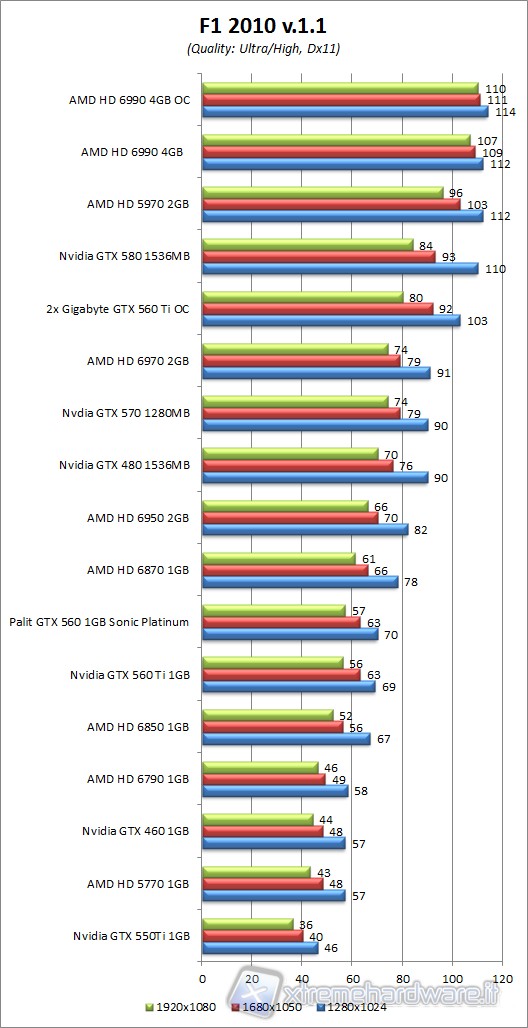
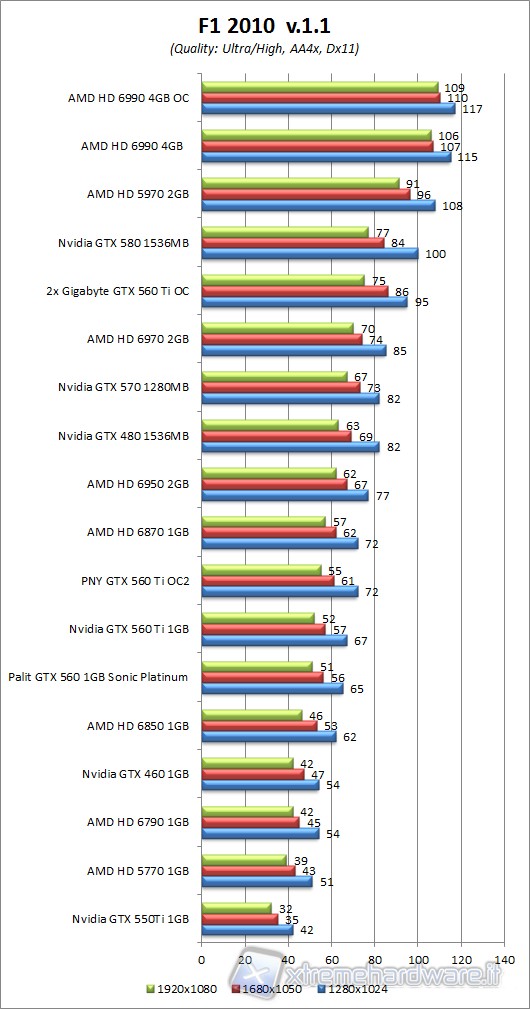
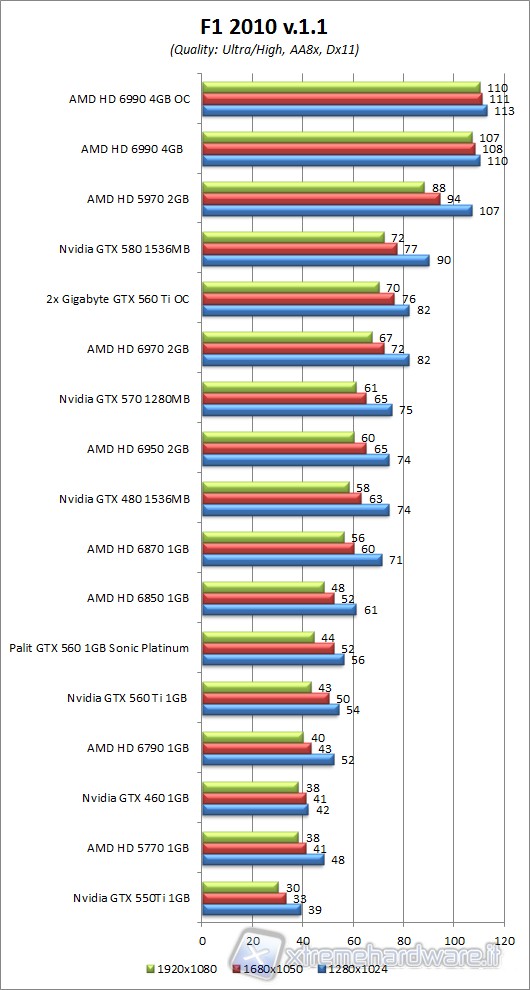
In the F1 2010 game, the video card is placed on the same level as the GeForce GTX 560 Ti, but below the AMD HD 6870 reference.
Palit GTX 560 Sonic Platinum: overclock
As we got to understand, Nvidia has left large margin of freedom to the AIB partners with regard to the operating frequencies. We wanted to further push the card produced by Palit and see the limit of the core and memory frequencies.
Overclocking was then performed using the Afterburn MSI software, the heir of Riva Tuner, which is very comprehensive and easy to use.
The first test was to use the default vGPU which in our case, as we noted by MSI Afterburner, is set to 1,000 V. This allowed us to reach a frequency of 950 MHz for the graphics core and 1900 MHz for the shaders, in full stability; you can see the screen performed with these settings:
We brought the GPU voltage to 1,087 V (from 1,000 V default on Afterburn MSI) and then we have increased frequencies to reach 1000 MHz on the GPU and 2000MHz for the shaders. Unfortunately it was not possible to overclock the memory as soon as they lifted their operating frequencies of even a few MHz, the system presented artifacts, so they were left to operate at their default 4200MHz frequency:
Palit GTX 560 Sonic Platinum: overclocking impact
We also wanted to see the incidence of this overclocking in the benchmarks and in games; you can see the result below:


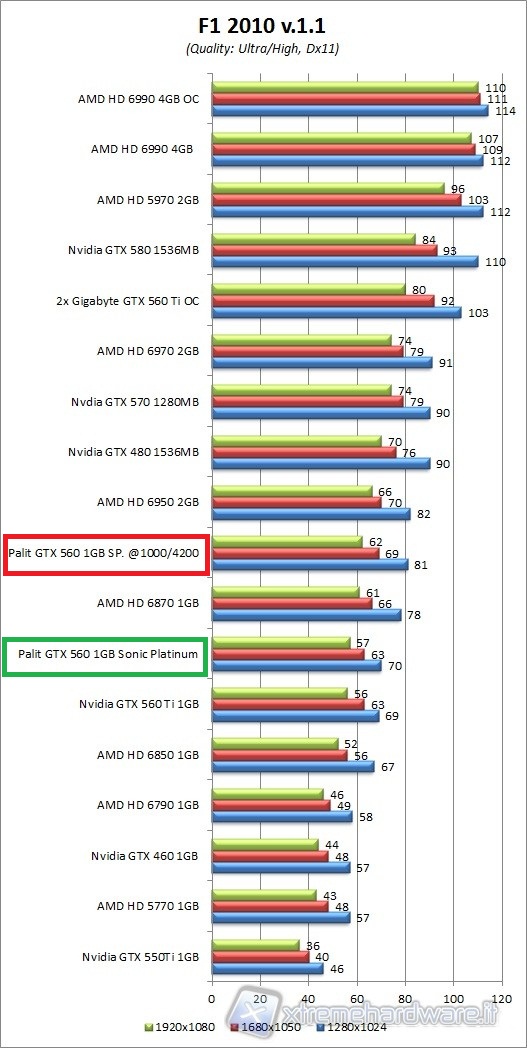
Going from 900 MHz by default to 1000 MHz in overclocking we found in some cases an increase of about 10%, depending on the type of application involved.
Palit GTX 560 Sonic Platinum: consumption, temperature and noise
The GTX 560 Sonic Platinum, being overclocked, usually has higher consumption than the basic versions.Let's see the consumption recorded below:
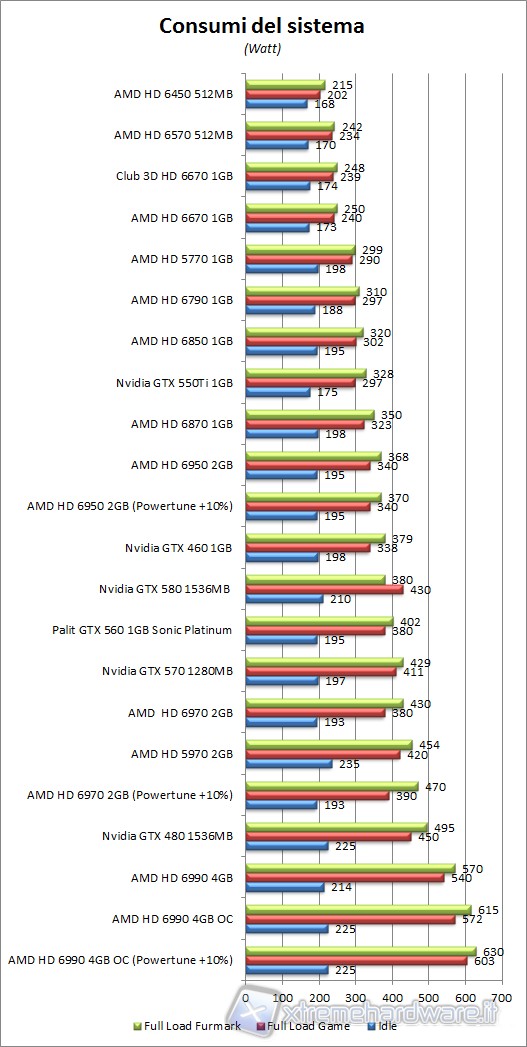
Using a current clamp, we measured power consumption at idle, during a gaming session and during use of FurMark stress tests.
The consumption which we have recorded are respectively, 195W when the card is in idle power, 380W in a normal gaming situation and 402W when we use the FurMark stress benchmark tool.
The cooling system used, that we analyzed a few pages ago, was able to cope well with the factory overclock ensuring even fairly small temperatures and very low noise level, indicating that for this card that Palit has done a great job.
The temperature recorded in gaming is 75°, while using the FurMark stress tool it oscillates around 82°, as you can see from the screen below:
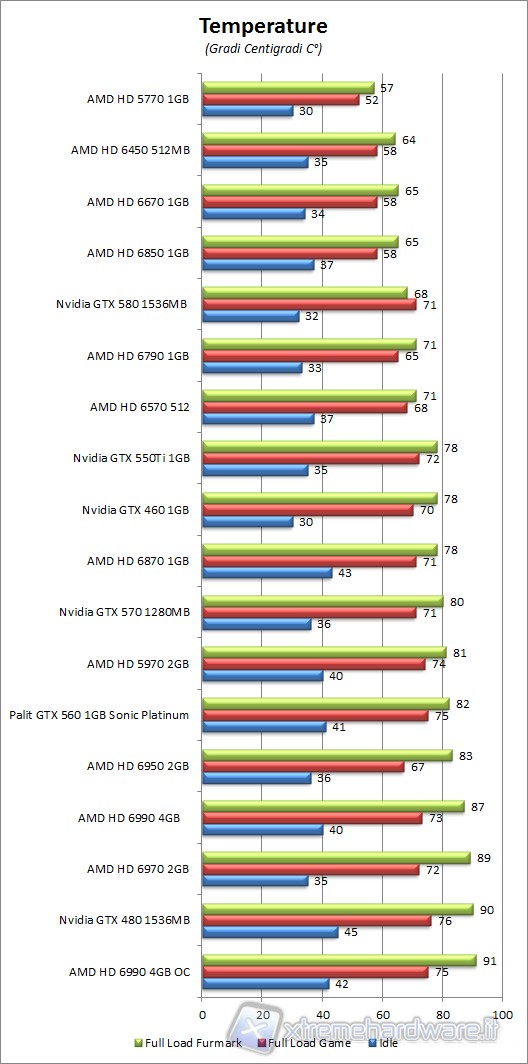
The fan used is fairly quiet at idle but also at full load. During the gaming session the noise was ever quite low, making it very quiet. Only by using the Furmark benchmark tool you can hear the fan, but this is an extreme situation that never occurs in the everyday use.
Palit GTX 560 Sonic Platinum: conclusions

| Performance: | |
| Quality/Price ratio: | |
| Overall: |
Palit GTX 560 Sonic Platinum card has made us a very good impression in many respects. With these frequencies has achieved excellent performance positioning that has always attested it to the level of a GeForce GTX 560 Ti. This is due to particularly pushed operating frequencies of the graphics core and memory: the graphics core, in fact, has a clock of 900 MHz while the memories are operating at 4200 MHz.
Analyzing the dissipating system instead it emerged that is able to keep the video card temperatures always good even when operating in heavy gaming, it also ensures that the noise level is very low. During the normal execution of games the card is extremely quiet.
Another point is surely the overall size of the card, making it a strong point. Because calculating the speed performance and considering the size, this card gets the highest marks in the card-size performance ratio. This implies that it can be easily placed in even the most reduced size cabinet, as often happens in micro-ATX or HTPC where those who want a high-level gaming card now can do this without considering large cabinet.
The Palit GTX 560 Sonic Platinum is sold at an official price of 190 € in our Italian market, although it is possible to found it at a price slightly lower in the international shops.
PROs
- Excellent performance
- Price more than justified
- Well-managed factory OC
- Possibility of further overclocking
- Quiet and efficient cooling system
- Compact overall size
CONs
- None
Thanks to Palit for giving us the card subject of this review.
Gianni Marotta
Translated by Marco Comerci
Through Direct2D technology, DirectX11 libraries also offer improved performance when using web browsing software like Internet Explorer 9 and Mozilla Firefox 4.0.
NVIDIA(R) PhysX(R)
With NVIDIA (R) PhysX (R) you can reach an element of realism never seen before in games.Using the NVIDIA (R) GeForce (R) on your PC, you can enjoy a dynamic experience with PhysX (R) effects like flaming explosions, reactive debris, water, and realistic characters with lifelike appearance.
Originally, this technology was used only by dedicated video cards that has been produced by the Ageia acquired by Nvidia in February 2008, and integrated into its GPUs starting from the GeForce 8 series.Through the implementation of the APEX library, PhysX technology has reached very high levels of realism, the first title to take advantage of the APEX library Mafia 2 was produced in August 2010. APEX libraries including the following features: APEX Destruction, APEX Clothing, APEX Vegetation and APEX Turbulence.


